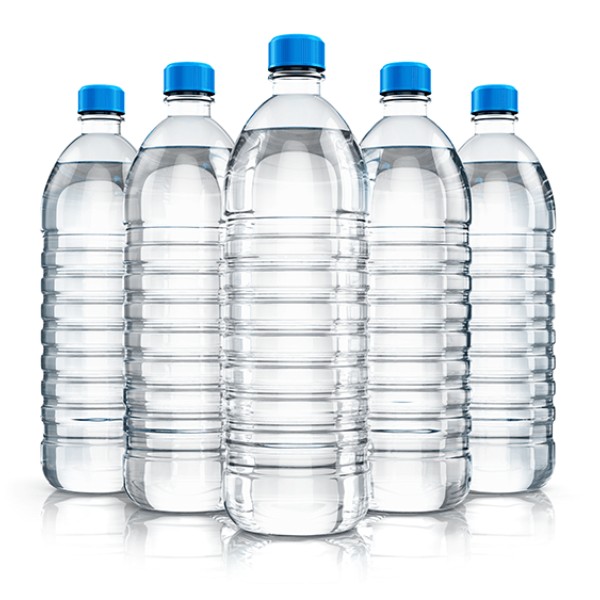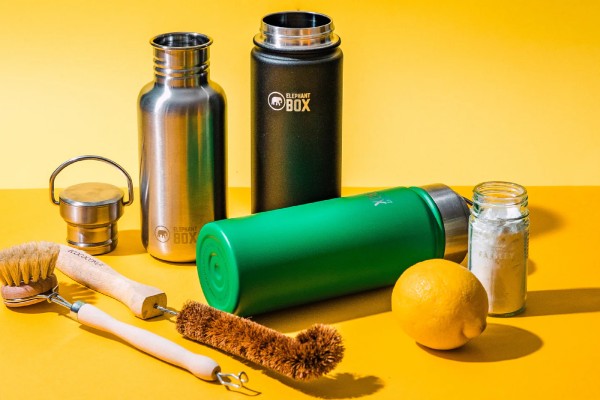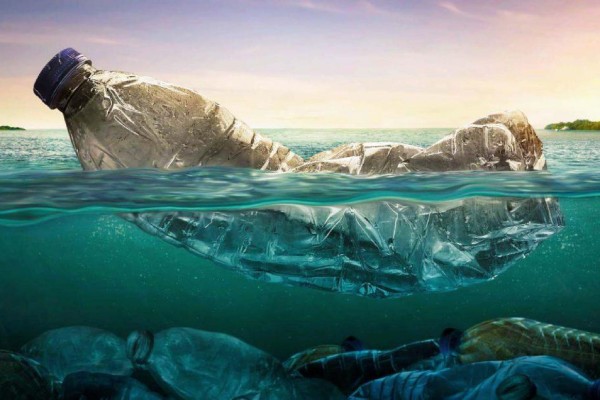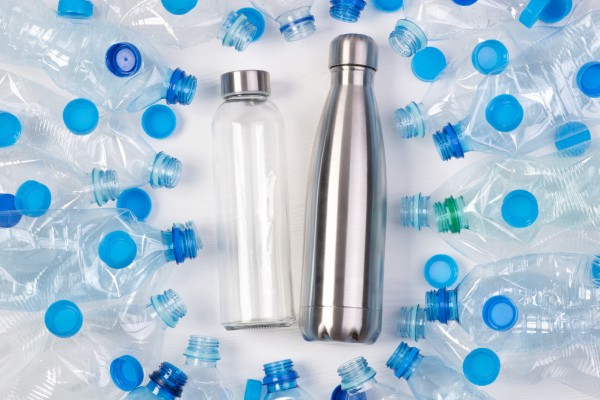Stay hydrated! Water makes up about 60% of the human body, which is important for the survival of human beings. Having a water bottle close to you will help you be able to drink a lot of water throughout the day. Keeping a water bottle might remind you that you need to drink more water. There are several types of water bottles available in the market to serve daily requirements and lead lifestyles accordingly. Large water bottles are good for road trips and day hikes. Insulated stainless steel bottles keep drinks cold or hot for hours. If you are looking for something a little more classic, then glass water bottles offer a chic and eco-friendly alternative. Additionally, colorful plastic bottles can add a fun and vibrant element to your hydration routine while being lightweight and convenient.
In this article, we will compare plastic and stainless steel water bottles to help you understand which one is better for your needs.
Plastic Water Bottles
Most plastic water bottles are manufactured using Polyethylene terephthalate (PET). These water bottles are commonly used to package beverages, primarily cold ones, but are not suitable for hot drinks. The bottles are lightweight, resistant to disposable, inexpensive, and protect drinks from moisture and chemicals.
While they are functionally used, plastic bottles have raised several health concerns and issues. Several studies have indicated that plastic bottles could leach chemicals into drinks, most especially those that have undergone high temperatures or long-term storage. While it has to be stated here that PET is normally labeled BPA-free, other noxious substances, including phthalates, can still get into the liquid. Additionally, research has found tiny plastic particles called microplastics in bottled water, which raises even more health concerns.

Besides health issues, plastic water bottles also create major environmental problems. While it has to be stated here that PET is normally labeled BPA-free, other noxious substances, including phthalates, can still get into the liquid. While plastic water bottles are convenient, they cause serious environmental and health problems.
Stainless Steel Water Bottles
Stainless steel water bottles are renowned for their longevity and durability. They are made from food-grade steel that resists drop and pressure. Many of these bottles have double-wall insulation which keeps drinks cold in hot weather and hot in cold weather while also preventing condensation on the outside.
Stainless steel is also fully recyclable, causing much less impact on the environment than plastic. Using stainless steel bottles helps reduce plastic waste, as they are recyclable and often support sustainability efforts. Similarly, these bottles do not retain flavors or odors from previous drinks, and they can be cleaned in a dishwasher or by hand with warm soapy water. If you find some buildup or odors in your stainless steel water bottle, you can easily clean them up with vinegar or baking soda.
Furthermore, even though stainless steel bottles are a bit more expensive than plastic bottles, they are worth it in the long run because they will not leach into their contents harmful chemicals.
Pros and Cons
Pros of Plastic Bottles
- Lightweight and inexpensive
- Convenient for short-term use
- Reusable
Cons of Plastic Bottles
- Possible health risks due to chemical leaching
- Environmental concerns regarding waste and recycling
Pros of Stainless Steel Bottles
- Robust, long-lasting, and corrosion-resistant
- Eco-friendly and Healthy
- Exceptional temperature retention
- Recyclable
Cons of Stainless Steel Bottles
- Relatively heavier than plastic ones
- Higher initial investment / Expensive

Also read: Here are 13 Bad Cleaning Habits You Need to Get Rid of ASAP!
Why choose stainless steel water bottles over plastic water bottles?
Stainless steel comes with a lot of benefits over plastic, including its durability, health quality compatibility with nature, and ease of maintenance. The following are the crucial reasons that make stainless steel a more favorable option:
Health Risks
Stainless steel has been considered a safer container for any liquid because it does not contain harmful chemicals. On the other hand, plastic bottles contain substances like Bisphenol A (BPA) and phthalates which can be dangerous to your health. These toxicants may leach into your drink, especially when the plastic undergoes heat exposure or after long-term use. Hence, this leaching causes various health disorders like hormonal changes, reproductive disorders, obesity, and certain cancers.
Insulation Technology
Most of the stainless steel bottles are designed to be able to handle double-wall insulation, and indeed they are very effective in preserving the temperature of beverages for long periods. This innovative insulation technology helps you to enjoy your drinks at their preferred temperatures. For example, hot beverages, such as coffee or tea, can keep their heat for several hours and provide warmth throughout your day. At the same time, cold drinks, like water or iced tea, can stay refreshingly cold for hours, in such a way, such bottles are especially useful in hot weather or right after a hard workout. However, plastic bottles cannot keep anything warm or cold longer which makes any drinks lukewarm in a very short period.
Bacterial growth
Plastic water bottles, especially those made from PET, have a porous surface with tiny cracks. Such cracks make these bottles difficult to clean and can lead to bacteria growing inside them. Moreover, they can retain odors and stains which end up gathering more bacteria if cleaning is not well done. On the other hand, stainless steel water bottles are produced with a smooth, non-porous surface that is less likely to collect bacteria. It has also been recorded in studies that stainless steel water bottles can remain comparatively clean even when they are not washed frequently because their surface is easy to wipe down. However, both types of bottles can still gather bacteria if they are not cleaned regularly. Stainless steel bottles may also be contaminated if they are not appropriately dried or cleaned after every use. While stainless steel bottles are more resistant to bacterial growth, regular cleaning makes both bottles safe and hygienic.
Environmental Impact
Stainless steel water bottles are sustainable and recyclable. Reusing such bottles saves resources and reduces the need for single-use plastics many times over. At the end of its life, a stainless steel bottle can be recycled, maintaining its quality and thereby reducing the amount of waste in landfills. Talking about plastic water bottles, they use a lot of fossil fuels. This process contributes to global warming and environmental pollution. Likewise, most plastic water bottles end up in landfills, where they may take up to 1,000 years to break down. While in landfills, they can leak harmful chemicals into the soil and water. Only about 30% of plastic bottles are collected for recycling, and even fewer are turned into new bottles. Furthermore, plastic bottles also contribute to ocean pollution. Plenty of marine animals die each year just because of plastic waste, including bottles which break down into tiny pieces called microplastics. In addition, there are various harmful substances present in bottled water that are detrimental to human life.
Sanitary Properties
Plastic water bottles usually pose sanitary issues. Single-use plastic bottles may not retain their shape or melt if repeatedly washed. This can lead to an accumulation of bacteria if they are reused without proper cleaning. On the other hand, stainless steel water bottles are known for their excellent sanitary properties. They are fully dishwasher safe, whereby one easily cleans them and gets rid of germs and bacteria. Regular washing on a dishwasher maintains hygiene since stainless steel does not hold the smell or taste of previously drunk liquids. In addition, they are resistant to rust and corrosion, which increases its durability and makes it easy to maintain cleanliness.
Aesthetic Appeal
Many people find stainless steel bottles have a greater aesthetic appeal than plastic water bottles due to their modern designs, durability, and customization options. Several brands even make customized bottles, such as engraved logos or unique patterns. These bottles have a sophisticated look associated with high-quality products due to their polished stainless steel surfaces. Moreover, they can also resist scratches and fading, therefore, keeping their attractive look for a longer period. In contrast, plastic water bottles often look less elegant and do not last as long, which makes them less attractive.

Conclusion
In conclusion, plastic water bottles are lightweight, inexpensive, and convenient for short-term use, however, they pose health risks due to potential chemical leaching and contribute significantly to environmental pollution. In contrast, stainless steel bottles are durable, recyclable, and do not retain harmful chemicals or odors, making them a healthier option. They offer better temperature retention and are easier to clean, although they are heavier and more expensive upfront.
Ultimately, choosing between plastic and stainless steel water bottles is not just a matter of personal preference. It is about making a responsible choice that affects both your health and the environment. So, which will you choose?
Frequently Asked Questions
1. Which is better, a plastic or stainless steel water bottle?
Stainless steel water bottles are better in terms of durability, health safety, and protection of the environment. They do not leach dangerous chemicals, retain odors or flavors, allow for metal contamination, and are completely recyclable. Plastic water bottles are light and inexpensive, which may be quite convenient if one intends to use them for very short-term purposes.
2. Are plastic water bottles safe to use?
Plastic water bottles are suitable for cold beverages, but they can be harmful to one’s health when used for hot liquids or when storing liquids for extended periods. The harmful chemicals of BPA and phthalates can leach into drinks, especially when heated.
3. How do stainless steel water bottles keep drinks cold?
Stainless steel water bottles often feature double-wall insulation, which helps maintain the temperature of beverages for hours. This means hot drinks stay hot, and cold drinks remain cold longer than in plastic bottles.
4. Can I recycle plastic water bottles?
Plastic water bottles can be recycled, but, only around 30% are typically collected for the recycling process. The rest go into landfills or oceans and cause pollution.
5. How often should I clean my water bottle?
Plastic and stainless steel water bottles need to be cleaned quite frequently after use. Amongst these, stainless steel bottles are easier to maintain and may be washed in the dishwasher. However, plastic ones require fairly frequent handwashing to prevent the bacteria from growing.
